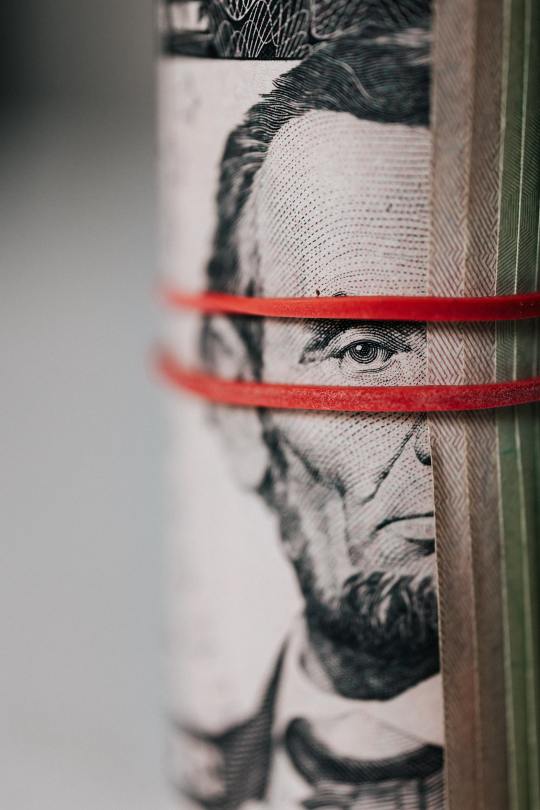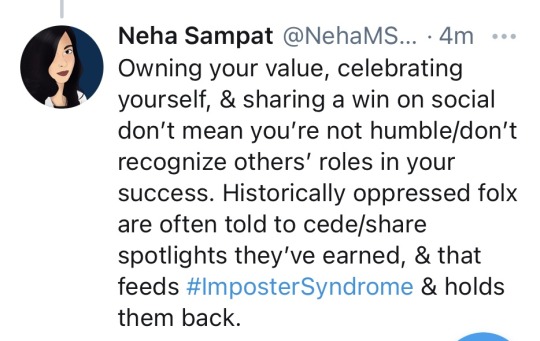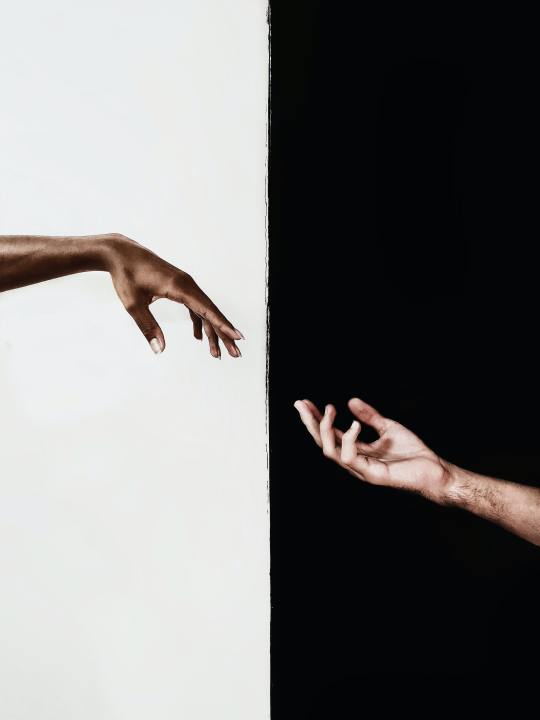Creating a world where everyone is part of the in-group
Don't wanna be here? Send us removal request.
Text
Walking a Minefield Without a Map: The Explosive Intersection of Well-Being and Belonging
by Neha Sampat, Esq.
(Originally published in Legal Management Magazine, Annual Print Edition 2022, available in full here.)

I was conducting interviews for a client’s belonging assessment, and I had asked everyone to come to their interview with a personal story of belonging or not belonging. At one interview, the interviewee remarked that they had struggled to identify a belonging story. I asked them why, and they explained: “Honestly, I can’t actually think of a time I didn’t belong.” During a later interview, a different interviewee lamented that they also had struggled to identify a belonging story. I asked them why, and they explained that they couldn’t remember the last time they did belong.
Does it surprise you to know that the former was a White man, and the latter was a Black woman?
Sadly, this situation is common. In our society, belonging is experienced as a privilege, with some (usually the White, male, cisgender, straight types) experiencing belonging as a given, while many others (usually the historically oppressed and the multi-marginalized) experiencing belonging as an audacious dream.
Yet, according to the study, “A Theory of Human Motivation” by A.H. Maslow, belonging is a core human need, following only physiological and safety needs. It’s a cornerstone of human well being — a sense of belonging cultivates a sense of meaningfulness in life, and a sense of meaningfulness in life is associated with overall well-being, as per the 2013 study, “To Belong Is to Matter: Sense of Belonging Enhances Meaning in Life.” Thwarted belonging leads to mental health challenges, including depression and anxiety.
Unfortunately, the workplace exacerbates historically excluded individuals’ struggle for belonging, thereby compounding their well-being challenges. For instance, a 2019 study of sexism against women in the workplace* confirmed that “sexism was associated with a poorer sense of belonging in the industry, which was associated with poorer mental health and job satisfaction.”
The rotten “isms” (e.g., sexism, racism, etc.) inequitably tax the well-being of the marginalized in many ways. For example, marginalized folks experience extra pressure for perfection because they actually are held to higher standards (as reported in an Atlantic article from 2015). This forces them to work exponentially harder to get just as far as their nonmarginalized counterparts. Their organizations often add under-compensated and under-valued diversity work to their already burdensome loads, all while providing them with little access to the built-in networks of support, mentorship and sponsorship that so many others take for granted. The marginalized are essentially pushed into a minefield without a map. Meanwhile, societal injustices continue to bombard them, traumatize them and chip away at their safety.
This challenge is formidable, yet addressable. Here are some ways for your legal organization to push through it.
1. De-silo diversity, equity, inclusion and belonging (DEIB) from other priorities in your firm — especially wellness. You cannot foster true inclusion without wellbeing, and you cannot cultivate well-being without true inclusion. Therefore, seed collaboration between your wellness and DEIB professionals and have them co-sponsor programs. Address bias and exclusion as root causes of mental health challenges, thereby centering the historically excluded in wellness conversations.
Make sure your DEIB programming addresses wellness. Kori Carew, Esq., Chief Inclusion & Diversity Officer at Seyfarth Shaw LLP, connects these dots and shares that among other actions, her department intentionally includes a wellness component in their DEIB programs. They’ve also equipped firm leaders with curated resources and tactics on “wellbeing and its intersection with connection and belonging.”
2. Double down on the work to stop harming the marginalized. Don’t teach folks how to walk the minefield. Instead, remove the mines: Tackle microaggressions (which, of course, are anything but “micro”), stop tokenizing, disrupt unconscious bias individually and systemically, foster allyship and advocacy, and build empathy.
3. Simultaneously, acknowledge that those on the receiving end of bias have suffered real harm, and dedicate resources to provide healing from that harm. Create safe spaces for connection and support within harmed communities, including in the form of well-resourced employee resource groups. Build a culture that acknowledges traumatic events and their disparate impact on the work and well-being of the most impacted communities.
Carew shares that, at her firm, they conduct regular wellbeing check-ins, and also make a special point to check in after national tragedies. Sometimes they’ll engage a psychotherapist to provide additional support. Some organizations even offer time off for people to process traumatic events.
4. In addition to healing, empower marginalized individuals, not to “fix” what’s wrong with them, but to remind them of what’s right with them. Invest in programs that help them bust through internalized bias and imposter syndrome, unlearn assimilation, and tap into their unique identities, experiences and voices as their superpowers.
Seek out and honor the unique aspects of marginalized folks that they have historically been forced to hide. For example, provide training on inclusive interviewing and inclusive leadership to create truly safe spaces for historically excluded folks. Build an environment that encourages others to bring more of their true and best selves to their work and their lives.
Ultimately, your greatest asset is a team diverse in identities, experiences and perspectives. Create space where each person is seen, valued and celebrated — a space void of minefields, where belonging (and the well-being that accompanies it) is experienced by all.
*A Confirmation Study of the Relations Between Workplace Sexism, Sense of Belonging, Mental Health, and Job Satisfaction Among Women in Male-Dominated Industries
#wellness#diversity#diversityandinclusion#wellbeing#inclusion#belonging#bias#impostersyndrome#deib#Dei
0 notes
Text
On Salary: Scrutinizing the Forces of Financial Oppression
By Neha Sampat, Esq.
February 4, 2022

As a brown girl coming from an immigrant family, there were several reasons I used to undervalue myself financially:
1. I was never taught to negotiate offers. I come from a background where we focused more on what we did have than what we didn't have, which kept me satisfied with initial offers...until I found out, for example, that my equivalently experienced white male colleague was making more than 1.5x what I was making!
2. Negotiation felt to me like rocking the boat, and as an immigrant family pressured to assimilate and lay low, we learned quickly that we were rarely able to rock the boat without being shoved overboard. This was compounded by external messages to me and my fellow marginalized folx to "just be grateful" for scraps instead of asking for more.
3. I didn’t have the connections and resources to empower me to negotiate. No mentor was teaching me the financial value of my skillset or how to access the secret salary ranges to which many of my colleagues were casually gifted access. And back then, there weren't the robust programs on negotiations, etc. for women and WOC that thankfully exist now (including, unironically, the Owning Your Value talks I now deliver).
4. I was comparing my salaries to what my family made, allowing myself to be limited by the lower bias-based financial ceilings that had limited their salaries. In other words, I was operating in a whole different financial league than many of my non-marginalized colleagues.
5. Even low/no cost asks I made were met with obstruction. For example, in a job for which I was woefully underpaid, I asked to take a professional development class that required nothing but my supervisor’s signature of approval (no financial cost). I was met with questioning instead of the encouraging and enthusiastic "yes!" I expected: "Well, aren't you too busy for the class?" When I asked them where they had gotten the idea that I was too busy during my personal time (as the class was not during work hours), they acknowledged that they didn't know.
6. Sadly, ambition is a bad look on people like me, and we often face confidence-backlash and pay a higher social cost of negotiation. Owning our worth is too often viewed as greed, and proclaiming our worth is too often viewed as arrogance. I remember coaching someone through a negotiation, and upon her reasonable counter to their initial offer, the employer pulled the offer! When I got off the phone with her, I sobbed not just for her and for me, but in frustration with a system that reinforces our fear to negotiate.
Here are a few ways I’ve learned to combat the harm done by these pressures (and I’m still learning!):
1. Rock the boat. Although nowhere near enough, norms have shifted a bit, with great thanks to bold boat-rockers and box-breakers, who have had the courage to defy stereotypes and expectations. I try to emulate them, accepting the risk of being labeled greedy/arrogant in order to more accurately acknowledge the value I bring and to change norms. As my privilege grows, so does my responsibility to change the rules.
2. Don’t just do it for you. The more you demand your value and get paid it, the more you get to pay others their value, and the more you cultivate fair market rates. The less you get paid your value, the less you can pay others theirs, and the less power you wield to make the market more equitable.
3. Demand salary transparency to the extent you have the power and privilege to do so.
4. Don’t let your past limit your future. You are not limited to what your parents made. You are not limited to what you made in your last job. (And that old salary really shouldn’t be anyone’s business but your own).
5. Recognize that you can be grateful AND want more at the same time.
6. Be the change. Offer salary transparency, and do not participate in the systemic exploitation of the marginalized. Understand the oppression- and bias-related reasons people undervalue themselves (including the ones I listed above), and work to make up for that. Invest in your mentees and direct reports as much as you can, financially and otherwise. When financial resources are legitimately low, give them other things that are valuable to them, especially when it comes to their professional development. Encourage them to dream big. And then support them in dreaming even bigger.
#salary#negotiation#equity#genderequity#diversity#inclusion#belonging#dei#deib#bias#confidence#impostersyndrome#owningyourvalue#compensation#payequity#diversityandinclusion#immigrants#southasian#minorities#marginalization
0 notes
Text
How Humbleness Has Been Weaponized
by Neha Sampat, Esq.
October 25, 2021

I recently saw a Twitter post recommending that individuals receiving a particular professional award refrain from centering themselves in posting about this honor and instead “be humble and stand out.” That advice raised a row of red flags for me.
This constant pitting of humbleness as oppositional to owning one’s value and standing in one’s accomplishments is part of what troubles me. As I explored in this video a while back, humbleness and humility are not mutually exclusive from confidence. One can be confident and own their value while also being hungry to learn more and grow!
Celebrating yourself does not mean that you do not celebrate others who helped you along your journey. Saying, “I’m great,” isn’t the same as saying, “I’m great, and no one else is!” Proclaiming your expertise doesn’t indicate you have nothing to learn from other experts.
One of the exercises I teach in our Owning Your Value workshops requires participants to first identify an accomplishment from their past. It can be personal or professional. It can be however big or small. It can be something they were lauded for or something no one else noticed but them. It can be anything, as long as it is an accomplishment that is meaningful to them. And yet…many people find it extremely difficult and painful to even think of one single accomplishment. Why is that?
We have been conditioned to not register our wins, to not sit with our successes, to not bask in the glory of our accomplishments, and this feeds our Imposter Syndrome. Some of this is due to our capitalist society that centers on perpetual productivity and incessant striving: We are too busy running on to the next thing to stop and appreciate the thing we just did!
But for many of us, this conditioning also is a tool of a system built on bias, oppression, and exclusion. A system that tells those of us who are marginalized that we belong at the margins and that others belong in the center, that we must cede the spotlight to them, and that what we have is due solely to what others gave to us. That we shouldn’t “brag” and should, instead, be humble. That we’re “not team players” when we acknowledge our individual contributions.
These pressures have taught us to make ourselves small: We deflect compliments (“Oh, it was the team!”), minimize our contributions (“Oh, it was nothing!”), and cautiously refrain from “making a big deal” about our experiences and perspectives.
Yet, ironically, while the system demands our smallness, it simultaneously expects us to deliver big, especially when compared to those in the majority. In a pivotal study conducted by Nextions, fictional Caucasian Thomas Meyer’s legal memo was rated by law firm partners at 4.1/5.0, while fictional African-American Thomas Meyer’s memo was rated 3.2/5.0. Spoiler alert: It was the same exact memo. And this is not just a racial discrepancy. As Professor Joan Williams points out, “women have to try twice as hard and show more skill than men to be viewed as equally capable.”
And even when many marginalized outperform others, their accomplishments still are questioned. Take, for instance, Simone Biles: She is the winningest gymnast in history who performs unrivaled skills at an unrivaled level. Yet, the International Gymnastics Federation undercut the scoring value for a vault move no other woman gymnast has even attempted, much less landed. They devalued her. And well before that, she weathered nasty criticism when she wore her infamous GOAT (i.e., “greatest of all time”) leotard. Even though she had the proof to back her claim of being GOAT, many came down hard on her for her confidence, calling her arrogant and describing her as not being a team player.
This “confidence backlash” is a tool of maintaining the heterogenous status quo and of keeping the historically oppressed small and at the margins. And it is directly related to the lack of representation at the highest levels of leadership in corporate America. A prerequisite to ascending into corporate leadership roles often is sponsorship, which is when other people openly and publicly vouch for someone’s expertise and legitimacy and connect them with the right opportunities and right people – in other words, say their names and speak their excellence. Yet, Black women in particular do not receive the sponsorship they need and deserve, and this has become a tremendous barrier to Black women in the C-Suite.
The harsh truth is this: Many of our historically marginalized and excluded colleagues do not get their excellence spoken by others (as it should be); their wins are erased and/or credited to others who then ascend the corporate ladder and perpetuate the problem. So how do we disrupt instead of perpetuate this?

Here are a few insights and tips to help you get comfortable with owning your value and with other people (especially marginalized professionals) owning theirs:
Build a culture of celebrating efforts and wins: Make it a normal part of the week or month to have each person on your team name something they did well, and celebrate that as a group.
Model confidence and humility as connected: Share openly what you’re good at, and share just as openly, what you’re still learning. Be able to say, “I’m proud of myself and I’m proud of so-and-so and so-and-so for what each of us brought to this situation.”
Vigilantly disrupt your unconscious biases: Check yourself every time you feel the urge to judge someone as arrogant, especially when that someone has been historically marginalized or oppressed. You may be operating out of your own unconscious bias. Look out for your mini-me bias so you are not just sponsoring those who remind you of yourself, but also are sponsoring those who have different identities and backgrounds from you. Make sure to sponsor and speak the excellence of the multiply marginalized (especially Black women).
Use your platform and privilege to laud others for their accomplishments and to champion them when they laud themselves: We have power over who are seen as thought leaders in our spaces, even just through the voices and accomplishments we choose to amplify and like on social media. This is how we change stereotypes such that a confident, melanated woman (for example) owning her accomplishments isn’t arrogant, but is instead powerful, capable, and successful. Seriously, go to social media right now, and amplify an accomplishment of someone who may normally face confidence backlash due to stereotypes and bias.
And finally, speaking of social media, please don’t tweet advice that folx should be humble instead of celebrating their professional recognitions. Because a humble person can also be someone who celebrates their accomplishments. And because many humble people need to do so in order to get the credit they deserve.
#confidence#Imposter Syndrome#diversityandinclusion#owningyourvalue#stereotypes#bias#racial bias#dei#team building#inclusion#belonging#social media
1 note
·
View note
Text
Sometimes feedback isn’t a gift.
by Neha Sampat, Esq.
September 9, 2021

Feedback is crucial to our individual and organizational progress. Yet, it has been over-glorified in our work culture: We are constantly told to seek out and internalize feedback without an acknowledgment that some feedback is destructive and limiting instead of constructive and lifting. In the early days of my business, feedback had me in a chokehold. I used to do evaluations at the end of every one of my trainings and talks, and inevitably, there would be those one or two grumpy evals that just didn't get me or what I was saying. I remember taking those very personally, letting that feedback erode my confidence and funkify my mood, and doing all I could to adapt myself and my work to respond to that feedback. I was choosing to turn up the volume on those few voices, until they drowned out the voices of the hundreds of people whose feedback on the same talk was glorious and growth-oriented. As I often teach in our Imposter Syndrome busting presentations, the doubting voices of others (“Who do you think you are?!) often become the doubting voice in our own heads (Who do I think I am?!), so we need to pull our fingers off the volume knob for a moment and think carefully, objectively, and realistically about the feedback we receive. Consider these three tips to help you filter feedback: 1. Remember that you are not here to make everyone happy. Just as everyone is not for you, you are not for everyone. Make peace with that, and disengage from your people-pleasing tendencies. If I tried to make the two grumpsters happy, I risked losing the hundreds of other folks who had experienced a tremendous positive life-shift from the same presentation. I had to reconnect with the impact I was trying to have on my target audience and let that help me filter out the limiting feedback. 2. Stay aligned with your goals. Does the feedback you received help you achieve your goals, even if the feedback may sting a little at first? If so, this may be the type of uncomfortable feedback you can get comfortable with receiving. Alternatively, would adapting to the feedback hinder you from achieving your goals? Then perhaps this feedback isn’t of service to you. 3. Is the person giving you the feedback invested in you and your growth? If so, try to be open to their feedback, as they are on your team. Good feedback is kind and caring and helps you be better and bigger. Bad feedback makes you small and keeps you caged.
Consider yourself not only as the receiver of feedback, but also as the giver of feedback. How do you deliver the good kind of feedback? Here are three tips to help you: 1. Ask yourself if the feedback you are giving comes at all from a place of jealousy (truthfully, each of us succumbs to the voice of the little green monster from time-to-time) or a place of love and caring. It is the loving and caring feedback that is constructive and lifting.
"When someone tells me I can't, really, what that means is THEY can't."
- Serena Williams (Check out this short video for more from Serena.)
2. Step outside of your perspective. Just because YOU couldn’t do it doesn’t mean THEY can’t. Feedback unfortunately is susceptible to our biases and actually can drive exclusion. Think about how you are defining success: Success is too-often defined in the mold of those who have been in powerful positions before. However, that group tends to be heterogenous and not very inclusive, so if we set competencies based on that narrow model of success, we are leaving out so many other creative, unique, and effective models of success. So, before you offer constructive feedback, ask yourself, “Am I measuring this person against old models of success, or am I helping them create new models of success?"
3. Make your feedback solution-oriented instead of problem-oriented. Good feedback is focused on what the recipient can do, not what they can’t do. How can your feedback help them improve and grow? If you are identifying a legitimate challenge, help them see how they can leverage their strengths to address their challenges. Be explicit about how this feedback will help them grow their amazingness.
After too long believing that I needed to always seek and believe all feedback, I thankfully finally realized that not all feedback is equal. We actually need to filter the feedback we give and the feedback we receive. In other words, don’t limit others or allow yourself to be limited, and give feedback that truly is a gift.
#feedback#growthmindset#Imposter Syndrome#self doubt#confidence#inclusion#bias#careerdevelopment#belonging#diversityandinclusion#impostersyndrome#empowerment#traininganddevelopment#leadershipdevelopment#manager
2 notes
·
View notes
Text
Dispelling Myths: Model Minorities and Meritocracy as Sources of Harm and Hierarchy
by Neha Sampat
May 25, 2021

The Model Minority Myth lauds Asian-Americans as somehow superior to other minorities and parades them as proof of meritocracy and the American Dream: If you work hard, you will succeed. In doing so, the Myth creates a false racial hierarchy, placing Asian-Americans right below White-Americans and above all other racial minorities, thereby serving as a tool of oppression of all other minorities, and more broadly, as a manifestation of White supremacy that harms all minorities, including Asian-Americans. It is a form of the colonial “divide-and-conquer” strategy of oppression that pits one minority group against the other to sustain the power and privilege of the colonizers. It plays out in its harm societally and personally, but it also causes tangible harm in the workplace and to different minorities in different ways as they navigate their careers and their lives.
Right from recruitment, the Model Minority Myth is used as a tool of oppression and exclusion. Whether intentional or unconscious, many organizations and recruiters are relieved to find Asian-American applicants because doing so allows them to “check the diversity box” without having to confront their own anti-Black, anti-Latinx, and/or anti-Indigenous bias. In this way, Asian-Americans sometimes are recruited as “diversity candidates” and showcased as “diversity hires” by organizations that are not truly diverse. And the idea of checking the diversity box of course means that this type of hiring of Asian-Americans is a form of tokenism, whereby the Asian-Americans hired are not valued for their unique skillsets, experiences, and perspectives, but are valued merely for their identities as Asian-Americans and the optics they provide, which ends up stifling their authentic engagement in their work. Then of course, the employment data showing greater employment of Asian-Americans than other racial groups, perpetuates the Myth itself: “Well, see, these Asians have no problem finding a job; why can’t other minorities be more like them?”
The Model Minority Myth also plays out in a negative way for minorities once they are in their jobs, particularly when it comes to career advancement and monetary valuation. The Myth requires Asian-Americans to play by the rules and not step outside the lines: Be happy with what you’re given; don’t ask for more. We see the negatives impacts of this on Asian-Americans play out when it comes to raises, in that Asian-Americans are the least likely among racial groups to ask for raises, and when broken down by gender, Asian-American women, specifically, are the even less likely. In fact, one study found that white men are 1.8 times more likely to ask for a raise than Asian-American women!
In my experience as an Asian-American woman who has worked specifically with Asian-Americans in their career development, it is fairly clear that Asian-Americans (and even moreso, Asian-American women) are socialized to be agreeable and not rock the boat, which gives us approval as “model minorities.” I’ve experienced this myself: Asking for a raise always felt to me like rocking the boat. It felt risky and, based on how I’ve been excluded in the past due to my race, I rightfully feared that I would be the one to fall overboard.
The Model Minority Myth also negatively impacts all minorities when it comes to promotion. Bolstered by the stereotype that Asians are hard and good workers, an Asian-American may get that promotion over the equivalently or even more qualified Black-American. That is an example of how Asian-Americans are positioned as a “wedge” between White-Americans and other minority races. However, Asian-Americans still hit a leadership ceiling at some point, with Asian-American white-collar workers being the least likely among racial groups to be promoted into management positions, and with White professionals about two times as likely to get promotions into management than Asian-Americans. Asian-Americans are allowed (and in fact are expected) to be good, but they are not allowed to be the best. They are allowed to follow, but not allowed to lead.
I’ve seen this mentality play out firsthand, even in the diversity, equity, inclusion, and belonging (DEIB) field, with the role of leadership being reserved for White people and with Asian-Americans being looked to as great soldiers and followers. I can’t tell you how many times I have been approached by White colleagues and fellow business owners, asking me to join their teams and support their missions because they “need more diversity” on their teams. This is a double whammy because I’m being tokenized for optics reasons while also being expected to be a good soldier for them, the leader. Unfortunately, it has been a rarer occasion when I’ve been approached by White colleagues asking how they can support my ideas for equity and inclusion and support my mission; how they can follow my lead.
This dynamic is not just limited to Asian-Americans (although Asian-Americans may feel uniquely pressed by their role as “model minorities” to go along with it). After the murder of George Floyd and the reignition of the racial justice movement, I noticed a surge in White-led racial justice and inclusion initiatives, which would not be so awful if many of these initiatives were not already being implemented and led by our Black sibling experts in this space. Instead of throwing their weight, power, resources, and privilege behind the great work already being done by Black experts, some were entering the space to replicate what had already been done and receive credit for it. White supremacy teaches White people that they are the leaders by default, and this plays out even in the DEIB field, oftentimes with many subconsciously perpetuating it.
In my work focusing on internalized bias, I also see the Model Minority Myth being internalized to the detriment of Asian-Americans: The Model Minority Myth sets up an unbending expectation that Asian-Americans excel, and the buy-in to the Myth of Meritocracy sets Asian-Americans up to believe that when they don’t excel, it is because they somehow underperformed or didn’t work hard enough. So when Asian-Americans don’t excel, they may feel like epic failures. There is no space for Asian-Americans who falter and thereby disrupt the hierarchy, and that lack of space feeds the invisibility of Asian-Americans when they don’t meet the impossible pressures for performance or when they disrupt stereotypes about their group. There is a set space carved out for Asian-Americans in the racial hierarchy, and if they don’t do what it takes to get into and stay in that space (no matter whom they have to step on and how they have to alter themselves), they belong nowhere.
Sadly both myths (Model Minority and Meritocracy) feed Imposter Syndrome in the Asian-American community. Imposter Syndrome is the false narrative that one is not good enough for the work one is doing or wants to be doing, combined with a fear of being discovered as a fraud. Although Imposter Syndrome is commonly experienced by all races, it runs rampant in the Asian-American community uniquely as a result of the external pressure the Model Minority Myth puts on Asian-Americans to achieve, excel, check all the boxes, and abide by all the rules, setting Asian-Americans up to constantly feel like they are coming up short. This can sow the seeds of self-doubt in their minds, which then grow and flower into anxiety and a constant drive towards perfectionism, all of which can result in self-sabotage and underperformance (reinforcing the false narrative) and can fuel significant mental health issues.
Thus, the Model Minority Myth and the connected Myth of Meritocracy cause tangible harm to non-Asian minorities in America as well as to Asian-Americans themselves. Too many among my Asian-American community have bought into the myths and thus become pawns of our White supremacist system. They are unable or unwilling to see the falsity of the myths and the harm caused to other minorities, and clearly, unable to see the harm caused to the Asian-American community itself. The harm is fact, while “model minorities” and “meritocracy” are fiction. Only by facing the harsh truth can we dispel these myths and disengage from the system of White supremacy that oppresses all minorities, including the so-called “model” ones.
#model minority#aapihm#aapi heritage month#diversity#diversity and inclusion#bias#white supremacy#racism#belonging#inclusion#meritocracy#model minority myth#critical race theory#asian american#workplace#tokenism
3 notes
·
View notes
Text
Belonging: An Inclusive Approach to Inclusion
By Neha Sampat, Esq.
(This article builds on a training the author provided to the ACCTLA Board in May 2019 and was originally printed in ACCTLA's The Verdict magazine.)

In 2001, right around the time I was starting my career as an attorney, African-Americans made up 1.28% of partners in law firms. This clearly was a problem. Even way back then, we as a profession decried awful statistics like these and promised to do better. In 2017, sixteen years and many, many millions of dollars later, the percentage of African-American partners in law firms was 1.83%. Math may not be my forté, but I know that is a 0.55% increase over 16 years.
That’s not a typo. And that certainly is not progress.
The legal profession’s stagnation with regard to diversity and inclusion is such old news that the stagnation itself has become stagnant.
There are a number of reasons why things haven’t changed. As a belonging strategist, consultant, speaker, and trainer, I work a lot in the legal industry, but also in other industries, so I get to see what sets us apart from other industries for both better and worse. On the worse side of the coin, we are very risk-averse: We aren’t comfortable with experimenting with bold initiatives, because we fear failure and worry it will define us. We are trained (for many good reasons) to mitigate risk, but it works against us when it keeps us stuck to the status quo.
We as a profession also are very competitive. That means that we want to do whatever it is our competitors are doing. “Does Firm A have a diversity committee? Oh, then we better create one, too.” We measure our success relative to others in our profession. “We beat the average by having 1.84% African-American partners. Yes! Success!”
Ok, I’m being a bit hyperbolic and more than a bit glass-half-empty, which is not my usual view of the world. So here’s the glass-half-full part: We don’t have to keep doing what we are doing that is not getting to where we really want to be. We are capable of learning, growing, and adjusting. In fact, as lawyers, we are really good at learning, gathering evidence, and reframing.
The big reframe I urge you to consider to earnestly start to move the needle on inclusion in our profession is to shift from a diversity and inclusion framework to a belonging framework. This is going to help you get unstuck from what hasn’t been working for decades and start addressing what the real issues are in an inherently inclusive way.
The Problem with Diversity
What is diversity? Diversity is most often about demographics and is measured by sheer numbers of people from specific categories of background, experiences, and/or traits. I see diversity as useful in that, by creating a critical mass of previously underrepresented folks, (1) Legal employers have a better chance of attracting even more folks of that particular background since people want to work where there are others to whom they can relate; and (2) Conceptually, legal employers have a better chance of decreasing implicit bias within the work environment since more folks will have increased exposure to and opportunities to connect and empathize with those who previously were from their out-groups.
But the problem with diversity is that its positive impacts are limited and precarious. If people from marginalized and unique backgrounds do not feel engaged and sincerely welcomed in their workplaces, it doesn’t matter how many of them there are; they will leave. And they will leave without having felt comfortable enough to share their authentic lived experiences and unique qualifications, so the bias-busting outcome doesn’t really pan out. Also, this approach breeds tokenism, a valuation of people for optics: “Oh you hired me because I’m brown and a woman. Not because of my merits and because of what makes me uniquely qualified.” This feeds into all sorts of problems that actually decay true equality, such as by nurturing internalized bias and Imposter Syndrome. It doesn’t explore how to engage with folks from diverse backgrounds and capitalize on their unique perspectives, which is a tremendous opportunity lost.
Diversity tends to focus more on recruitment and hiring than on retention, engagement, and development, so it is very short-sighted. And that’s where inclusion comes into play.
The Illusion of Inclusion
What is inclusion? Inclusion is most often initiated and evaluated from the perspective of the organization and/or organizational leaders and implies efforts made to engage folks from diverse categories of background, experience, and/or traits. It focuses more on retention, engagement, and development, which signals an evolution from the diversity framework. However, inclusion commonly is implemented based on assumptions and on sweeping generalizations. It ignores the goldmine of data that is found in the lived experiences and perspectives of every person in the organization. So it is a very top-down approach to inclusion, one that is not very inclusive in how it is implemented, and one that often exacerbates a disconnect between the people in an organization and its leadership.
How do you get to a truer form of inclusion? One that identifies the true strengths of an organization and the true pain points of an organization. How do you address the right challenges in the right way? By shifting to a “belonging” framework.
The Benefits of Belonging
What is belonging? Whereas “diversity” is “you get me into your org,” and “inclusion” is “you make an effort to include me,” “belonging” is “you make the right efforts such that I feel seen, understood, and valued.” Belonging is for everyone; just ask Maslow.
That said, belonging can feel uncomfortable as a concept in that it may appear to be too touchy-feely and subjective. As lawyers, we are trained to discredit the subjective. We always look for objective data and aggregations. But we lose so much in this process. We tell ourselves and our colleagues that our lived experiences and perspectives don’t matter, and we don’t feel comfortable sharing our authentic selves, which leads to job dissatisfaction, disengagement, disconnection, and stress. To adapt to a belonging framework, we need to expand our definition of data to include the lived experiences and perspectives of each individual in our organizations. We need to remember from our work as attorneys the unrivaled power of a story and make room for our own stories and stories of those in our organizations.
Belonging is subjective. It can mean different things to different people. What it takes for me to feel that I belong in a particular organization may be different than what it takes for you to feel that you belong in that same organization. So a cornerstone in building belonging is to ask and help each individual define for you what belonging means to them and what you can do as an organization for them to belong. Have each member of your organization tell stories of specific times when they experienced belonging and when they did not experience belonging. You then will start to identify the real pain points in your organization instead of assuming what the pain points might be. That will allow to you address your organization’s true challenges by leveraging your organization’s true strengths. You’ll be solving the right problems in the right ways. And you will have sent a message to everyone in your organization that their voice and experience matter from the get-go. This is what makes belonging a truly inclusive approach to inclusion.
How to Implement a Belonging Framework
A belonging framework requires a particular process that engages each of the individuals in an organization and moves forward from there. I have been working with a number of bold and dedicated law firms and teams on taking a belonging approach by first conducting belonging and engagement assessments for them via anonymous surveys as well as confidential interviews and focus groups. I then analyze the data and share back with them themes and insights. The org/team then has a sense of what is required to create a sense of belonging for all and where they may be falling short. I then help them harness this data into a strategy for true inclusion, and we then implement this strategy.
Along the way, we tend to unearth and address many common hidden barriers to belonging, ones that tend to go under-recognized and under-addressed in the diversity framework, including:
Unconscious bias with organizational activation (many of us have attended unconscious bias workshops with limited to no follow-through, and that has been found to sometimes backfire.)
Internalized bias and Imposter Syndrome – Along with reducing the bias bouncing around in our organizations, we also must acknowledge the damage already done by the bias our marginalized populations have faced in our workplaces and in their lives. We must empower them to recognize and uproot this internalized bias. One very common hidden barrier to belonging is the feeling of not belonging cognitively that, for some, is tied to internalized bias. This can manifest as a particularly destructive form of self-doubt called Imposter Syndrome that is very prevalent among high-achieving lawyers and is also very addressable.
Generational friction – Many younger attorneys experience a sense of not belonging in the profession due to the profession’s traditional hierarchy, and with the leadership retiring out soon, many firms are finding themselves facing a succession crisis, so creating belonging for members of all generations becomes a priority.
These approaches are not ones that get a lot of attention in our profession because they are not part of what our profession has been doing over the past few decades. But the time has long ago come for change, and if we can let the voices of everyone in our organizations guide us, we can feel confident that we are catalyzing the right kind of change. This type of change keeps attorneys with diverse backgrounds in our organizations and our profession, honors and takes their lead, and eventually leads to even more individuals with unique backgrounds and perspectives wanting to join us, because they know we have created a place where they know they are seen, understood, valued, and championed. Where they belong.
#belonging#inclusion#diversity#diversity and inclusion#Imposter Syndrome#bias#lawyers#law firm#legal profession#deib#dei#storytelling#inclusiveleadership
2 notes
·
View notes
Text
Gaslighting: A Tool of Oppression and Exclusion
by Alisha Patel, Communications & Research Fellow at GenLead|BelongLab
February 2, 2021

“I don’t see color.” This is one of the most common phrases people will use to defend themselves against accusations of racism. It isn’t the best, but at least it’s not explicitly racist, right? In a culture where calling out institutional and systemic racism feels like an ongoing battle that’s fought tiny steps at a time, that phrase feels like an adequate place to start. However, this phrase is actually a form of racial gaslighting, and its acceptance only perpetuates stereotypes and the racism we are trying to fight.
Gaslighting in general is a form of manipulation and psychological abuse where the perpetrator convinces the victim that they are imagining or overreacting to abuse. Over time, this can solidify the perpetrator’s position of power over the victim, turning it into an ongoing cycle of abuse. The effects of gaslighting are extensive-- the victim will start to second guess themselves and their judgments. While this form of manipulation is often talked about with regard to personal relationships, it can additionally be used to to cloak bigotry like racism.
Racial Gaslighting
Racial gaslighting often is used to excuse microaggressions in all forms. It can invalidate someone’s experience of perceived racism by subtly denying their feelings and emotions, excusing implicit comments meant to demean or discredit them, or even excusing explicit attacks on them. Its effects are grave; it subtly reinforces and sustains racial and social hierarchies that inevitably hurt minority groups. Not only does racial gaslighting allow stereotypes to continue, but it also degrades the victim’s sense of self and teaches them to invalidate their own instincts and judgments.
For example, imagine if someone had experienced racism in the workplace and attempted to tell a fellow coworker about the incident; instead of empathizing, the coworker reassured the victim “it couldn’t possibly be racism,” “it is all in your head,” or “you’re too sensitive.” Statements like this place the perpetrator in a position of power and control under the guise of morality, while undermining the victim’s experience as lesser-than. In turn, the victim can develop feelings of anxiety and depression as they start believing they cannot trust themselves and cannot express their emotions outwardly. According to clinical psychologist Dr. Roberta Babb, racial gaslighting also, “overtly and covertly erodes a person’s sense of self, self-worth, agency and confidence.” Thus, racial gaslighting feeds internalized oppression and Imposter Syndrome.
Racial gaslighting is so common that it is sometimes difficult to tell when it is happening, and it can even be unconscious or unintentional. Normalized phrases like “I don’t see color” seem to mean well at first glance, but in actuality serve to invalidate the struggles of a minority group while erasing the group’s lived history. It tells the listener, quite unequivocally, “I am not racist. What you are perceiving as racism on my part cannot possibly be racism.” Phrases like these are un-nuanced and oversimplified takes that may have been accepted in the past, but as we learn more about deep and entrenched racism, we see they are outdated, insensitive, and quite frankly, racist.
This type of manipulation often is used by mainstream media and people in power, ingraining its use in our culture and further highlighting the power dynamics underpinning racial gaslighting. Think of Donald Trump and his response to protest movements through the past year: On one hand, he refused to condemn Neo-Nazi protestors, saying there were “fine people on both sides.” But he mischaracterized Black Lives Matter protests calling for an end to police brutality as thugs and threatened them with the National Guard, warning “when the looting starts, the shooting starts.” He then mischaracterized the white supremacist, violent insurrection he incited on January 6th as a march, declaring his love for the insurrectionists. According to Trump, white supremacists are allowed the benefit of the doubt and could possibly be good people at heart. Yet, those in support of black lives are automatically dangerous and should be perceived as a threat. With these statements, Donald Trump at once validates the platform of white supremacists while invalidating black lives in the United States and negating the idea that racism is a problem; he normalizes the presence of white supremacy while revealing the inability of the country to acknowledge its inherent racism and bigotry. Anyone witnessing photos and images of how the BLM protesters were treated versus how the white supremacist insurrectionists were treated at our Capitol can see that racial gaslighting has deeply permeated our country systemically and is a problem that outlives the Trump presidency.
Gender Gaslighting
Also problematic is gender gaslighting, where a woman may not feel comfortable voicing concerns about sexism because her concerns are automatically dismissed. Consider a woman -- let’s call her Jana -- who has been working for a company for many years and is very qualified for a promotion. Yet every time Jana expects to be promoted, a man is given the promotion instead, even though he has had less time at the company and is not as qualified. Jana may attempt to discuss this with her boss, but he insists it has nothing to do with her gender; he tells her she is overanalyzing the situation and being over-sensitive. While it is possible that Jana’s boss could be telling the truth, it is more likely that her gender is in fact playing a role in not receiving a promotion, as this pattern has repeated multiple times. However, Jana has learned that she does not have a space to speak up about this sexism, will likely be negatively judged for speaking up and thus have an even harder time getting that promotion, and therefore most likely will not attempt to speak up again. This is the same situation that is seen with racial gaslighting-- the cycle will continue for Jana, and her emotions may inevitably turn inwards, convincing her that she is not qualified for any promotion and deserves to be limited to her current level.
COVID-19 Gaslighting
We even see gaslighting around COVID-19. As a college student at a very urban university, the pandemic has shaken up every single aspect of college life. Though my school has adjusted as best as possible (we are tested twice a week and receive our results within 24 hours; most classes are online and if they aren’t, there are usually less than five people in-person, all socially-distanced; so on and so forth), interacting with other students and people my age really reveals the mindset around the pandemic.
As the pandemic has raged on, it feels as though people have accepted its presence, or stopped caring altogether. It’s a stark difference from the first lockdown in March, where it felt (at least for the most part) that everyone was on the same page. But now, instead of staying inside and mitigating the impacts of the pandemic, it feels as though it’s now a matter of working around the pandemic to do things we used to do. Those who are still staying inside have become more of the minority than the majority, and are sometimes gaslighted to feel overly paranoid for continuing to take the pandemic seriously. This gaslighting is clearly very harmful to society as a whole, as it simultaneously perpetuates coronavirus while undermining common sense and the empathy to care about the collective nation.
COVID gaslighting can exist on a small interpersonal level. Consider a situation where two friends want to get together, but one is insisting on following social distancing regulations while the other is suggesting to abandon them altogether. The one wanting to abandon social distancing may claim that they have both been isolating themselves since the beginning of the pandemic, and it is unlikely that they could infect each other. They may go on to call their friend overly paranoid of the virus and accuse them of not wanting to get together. Though this is not actually the case, the friend who was attempting to follow COVID regulations is made to be the villain, which is a common gaslighting mechanism.
Even worse, COVID gaslighting has been perpetuated by some people in power, who can afford to preach a careless and selfish mentality around COVID-19 because, even when they contract the virus, they have the money, power, and resources to combat it. Meanwhile, they continue to manipulate the American public into believing that COVID is not something to be taken seriously.Their followers adopt the same invincible mindset, but it is clear that they -- and most other average Americans -- are not in the same situation and do not have the same money and resources to combat COVID if needed. The situation is even worse for identity groups that have been historically oppressed.
Many Black and brown communities are disproportionately affected by COVID-19: African-Americans deaths are two times higher than would be expected for their population, and it is the same for Hispanics and Latinos. On the other hand, white deaths from COVID are “lower than their share of the population in 37 states.” These disparities result from institutionalized and systemic racism (fed by racial gaslighting) that has been snowballing since our country’s inception.
Combatting Racism by Contending with Gaslighting
It is in no way, shape, or form the victim’s responsibility to attempt to change their gaslighter’s behavior. Instead, it is important for us to create safe spaces for these victims to be heard and validated. Thus, putting a stop to gaslighting begins by looking inwardly at our own behavior and preconceived biases; particularly, if you find yourself recognizing some of the behaviors symptomatic of gaslighting, it may be wise to engage in self-introspection and attempt to accept some responsibility. Though some gaslighting may be done unintentionally or what you believed to be well-meaning, it clearly is still harmful and must be mitigated. To confront the biases that may underlie your possible gaslighting of others, you can also take this online test that examines and assesses internal biases that you may not have even noticed (it takes about 10-15 minutes). Attempt to challenge these internal biases, and pay attention to how they affect your interactions with others.
Additionally, be prepared and open to truly listen to and learn from other people and their experiences, and focus on increasing your awareness of others’ circumstances. These steps can begin the process of acknowledging gaslighter responsibility. By first starting on a personal scale, we can expand this introspection to a larger scale and begin holding the racist systems in our country accountable.
If you find yourself a victim of gaslighting, it is important to safeguard your mental health. This can be done by taking a step back from the situation and removing yourself from the environment to consider the hurtful behavior and resulting emotions. You can write down your thoughts to affirm your judgement as valid and for reference if necessary. It also can be helpful to talk with other members of your identity group and share experiences like this. Affirmation from others with similar circumstances can validate your experience of harmful gaslighting and remind you that you are not alone. This can help you to trust yourself more as well as recognize the gaslighting as it is happening.
In the moment gaslighting is occurring, it is important to call out the behavior publicly (when possible and safe to do so), showing the perpetrator and others in proximity that the behavior is inappropriate and will not be tolerated. Further (again, to the extent safe and not harmful), you can talk one-on-one with the perpetrator to discuss the behavior, making sure to describe the behavior and why it is harmful. Setting boundaries (e.g., taking a step back, removing yourself from the situation, as described above) will help to loosen any grip the negative environment or perpetrator may have on you.
As an ally, it is important to help support victims of racial gaslighting by helping to call out the unacceptable behavior, as well as creating a safe space for victims to express themselves and be heard and respected. Make sure that what you are doing is not self-indulgent or performative, but rather is truly helpful to the victim and in their self interest.
Combatting racism in a present day context is not an easy task -- it is extremely complicated and has far-reaching and entrenched roots in the United States. That said, the task should begin with dismantling the practices that perpetuate racism on interpersonal and societal scales. By recognizing racial gaslighting, it is possible to disrupt stereotypes and racial hierarchies, while also offering the historically oppressed, excluded, and marginalized a safe space to speak and be heard, which uncloaks hard truths from underneath imposed false narratives. Those who insist they don’t see color are not seeing people of color and their lived experiences.
Without seeing the hard truths, we are unable to address them.
#genderequity#racialequity#belonging#bias#gaslighting#impostersyndrome#diversity#inclusion#racism#allyship#equity#deib#dei#diversityandinclusion#internalizedoppression#internalizedbias#covid19#power#leadership#inclusiveleadership#stereotypes#colorblind
3 notes
·
View notes
Text
More than fed up with being labeled “less than”
by Neha Sampat, Esq.(!)
December 15, 2020
You know what bothers me about the whole brouhaha (or shall I call it “bro”haha) about Dr. Jill Biden’s use of her earned title? It’s not just Joseph Epstein’s mega-misogyny or even that the Wall Street Journal chose to publish the piece and then doubled-down on their bad judgment. That this [bleepity-bleeper] had the audacity to think he can publicly cut down someone who has out-schooled, out-accomplished, and clearly out-classed him says a lot about our society. He and the WSJ made themselves easy targets, and trust me, I’m not here to block your aim at them.
But what also is bugging me is the fact that Epstein and the WSJ gave voice and amplification to a too commonly shared notion that women are “less than” and should be maintained as “less than” by being cut down when they reach beyond the confines of the patriarchy and threaten those glass ceilings. This notion is so commonly shared that I suspect many of all gender identities first bristled when they heard Dr. Biden referred to or introduced as “Dr.” I teach people (especially women) to shout from the rooftops about their accomplishments, I try to model that by standing firmly and publicly in my own expertise, and one of my dearest and oldest friends is a brilliant woman with a PhD. But I admit (with horror) that even I was momentarily startled at first when I heard Dr. Biden introduced as “Dr.” a while back, and I had to take a good, hard look at myself to explore why.
So, like it or not, we now have an opportunity to look inside ourselves to examine our own biases (even the women among us harbor bias against ourselves and other women). Were you taken aback (even ever so slightly) when you first heard/read Dr. Biden introduced with her title? Did it bug you in the slightest bit to hear her husband and her referred to as “Joe Biden and Dr. Jill Biden?” Hmmm…why is that? Please, take a moment to sit with this, as it will help you de-bias yourself, and we all need to constantly be combatting our biases.
And, yes, this also is an opportunity to look outside ourselves at a culture that allows for (and in fact rewards) the cutting down of women and the minimizing of their accomplishments. Don’t even get me started on how multiply and historically excluded women such as WOC (and especially Black women) have their achievements and expertise questioned, belittled, and censored on a daily basis and to a far greater extent than most others! (Check out how Dr. Timnit Gebru was treated by Google, and read The Memo by the incomparable Minda Harts to learn more.) This absolutely is a societal, structural, and organizational issue.
Parallel to the Dr. Biden story hitting the headlines, I had been noticing a number of programs and posts attempting to debunk Imposter Syndrome, including some from colleagues I admire and trust. Yet, I have observed (and experienced, myself) Imposter Syndrome as a very real struggle. (I do wish we had another name for it that could be universally recognized; I’ll work on that).
Where I think my colleagues and I agree is here: Imposter Syndrome is not another externally-imposed mark against those who have it (which, by the way, is most of us). Imposter Syndrome is not a disease or personality flaw. It is not self-inflicted. It is not a black or brown person issue. It is not a women issue. There are plenty of black and brown women, for example, who don’t struggle with it, so let’s be careful about making generalizations. Imposter Syndrome is a human issue.
That said, the causes of it for historically excluded people are unique: Imposter Syndrome is a manifestation of internalized bias/oppression for many of us. Imposter Syndrome is the damage done by a society built on exclusion and othering, bias, prejudice, and marginalization. When Dr. Biden and other women are told their doctorates don’t matter and have their expertise publicly questioned on such a powerful platform, they (and all other women) are being told that they are not good enough, that they don’t matter, that they are “too big for their britches” (a phrase Dr. Brené Brown satisfyingly dismantles in her work). When the world is constantly telling you that you are not the giant force you are, you may start believing it. That voice of the doubters can become the voice in your own head that tells you that you are out of your league, that you are maybe not so great, that you are “less than.” That’s how Epstein’s effort to take down Dr. Biden serves as a perfect example of how Imposter Syndrome can be created.
By acknowledging Imposter Syndrome is real, we are not saying that it is the fault of the people who have it, and we are not letting off the hook the excluders and otherers, the biased and prejudiced, and the structures that support them. Society and orgs create and cultivate systems that birth and feed Imposter Syndrome. They are the cause, and Imposter Syndrome is the effect. Work must be done on societal and organizational levels to address this (and we are proud to do that work!). But at the same time, healing can happen in the individuals who experience Imposter Syndrome as a form of the harm done to them. External oppression does not have to become internalized oppression.

Thus, it has been so heartening to me to see women publicly claim (and for some, reclaim) their earned titles on social media this past week. We as women shouldn’t have to offer proof of our academic and other accomplishments to be taken seriously, but the truth is that we are constantly having to prove ourselves worthy of respect. By stating our credentials, we are honoring ourselves and our achievements and also honoring the credential itself by letting it sit proudly next to our blessed names.
I don’t have Ed.D., but you can bet that if I did, you’d know about it! But I have other achievements of which I am proud and which position me uniquely to make this world better in ways only I can. You, too, have achievements and credentials that position you uniquely to make this world better in ways only you can.
As we close out this year (finally!), I’d like to refer you back to a blog post we wrote to close out 2018, “Wrapping Up the Year: Turning the Page from To-Do to Ta-Da,” which empowers and encourages you to take a reflective moment to honor all that you did (your “ta-das”) this past year. But let’s take it a step further this year: Once you note your ta-das from 2020, I challenge you to boldly share at least one of your ta-das publicly. It can be on social media, or it can be with someone with whom you normally wouldn’t share it. By doing so, you practice owning (and believing) your own value and, like Dr. Biden so beautifully does, you create space for all people to stand strong in their expertise and be valued and celebrated for it!

#drjillbiden#deib#impostersyndrome#belonging#genderequity#women#drbiden#inclusion#discrimination#diversity#leadership#equity#bias#prejudice#timnitgebru#newyear#confidence#expertise#doctorate#phd#achievement#accomplishments#expert
2 notes
·
View notes
Text
“I’m speaking:” Building the confidence to speak up for ourselves and others
by Neha Sampat, Esq.
October 9, 2020

I certainly have been feeling a greater drive from within myself recently to speak up for what is right and to speak up against what is wrong. Do you know what I mean?
So many individuals and organizations have been contacting us to explore programs on allyship and how to build a culture of speaking up. But this is not just a cultural issue; it is also an individual issue. How do we as individuals cultivate the courage to speak up and to not be spoken over? An important yet often overlooked truth is that we build this courage as we build our confidence in ourselves, our voices, and our unique perspectives.
Confidence and courage to speak up are inextricably connected.
I remember with deep shame times I haven’t spoken up, whether it would have been to advocate for myself or to advocate for others. I remember witnessing a white woman say something so obnoxious and offensive to a Black woman that I questioned whether I had heard it correctly. I distrusted my own ears and my own perceptions. I doubted myself and my perception of what had just transpired and immediately judged that I was the one who must be wrong! I feared the conflict that might arise if I did speak up and didn’t believe in my ability to navigate that conflict. A false sense of comfort (because my conscience didn’t allow me to be truly comfortable) mattered more to me than kindling conflict in order to do the right thing.
So I didn’t speak up, and I let that moment slip by me, my silence compounding the harm done.
As I started to intentionally tackle my own Imposter Syndrome, address my internalized oppression, and build my confidence, I discovered my voice and practiced not only amplifying it, but not letting it be talked over or twisted. That allowed my conscience and values to drive my actions, and I began to speak out and speak up more and more against injustice. I began to put more of myself on the line to advocate for what was right. And the more I spoke up, the more confident I felt in my voice and in my ability to navigate conflict. The more I could speak in alignment with my values, the less I felt like a fraud, and the more I was able to own my unique value.
As you work on building a culture of calling people in and speaking up and activating for racial justice, please explore within yourself and your org the role Imposter Syndrome and self-doubt may be playing as an obstacle. Check out this truly enjoyable conversation I recently had with my friend, Sarah Nichols, on her fantastic podcast The Women’s Advocate, where we discussed Imposter Syndrome, belonging, and speaking truth to power.
0 notes
Text
On Allies and Self-Advocacy
By Neha Sampat, Esq.
September 9, 2020
During a recent panel discussion on difficult conversations about race at work, an attendee expressed appreciation for allies, but asked from the perspective of the marginalized, “At some point though, we should be able to handle such discussions on our own. How do we make it to that next step, where we can advocate for ourselves without fear of repercussion?”

There are two sides to this, and both are necessary to create the possibility of marginalized people advocating for themselves without fear of repercussion:
First, there is the systemic side - what the allies and orgs can do to create space for safe self-advocacy of the marginalized. Repercussion means that someone else holds something against the speaker and puts into action a negative consequence for the speaker. So the removal of repercussion is not up to the speaker, but up to the people around the speaker, the org, and society at large. Thus, there must be clear policies against repercussion, training to address the biases that often underlie repercussion, and a safe avenue for reporting up the negative repercussion suffered and having the negative repercussion sufficiently addressed.
But this does not mean the speaker has nothing they can do to put themselves in a better position to advocate for themselves, so we must examine the speaker side. Racial minorities and other marginalized populations’ voices have been excluded, muffled, devalued, silenced, and mocked. Their input, when tolerated or even when welcomed, has often been appropriated by others. They are often gaslighted to discredit their own perspectives and experiences. They have been required to adapt themselves to fit a restrictive mold of “success” not created by or for them.
These are all aspects of systemic racism and other -isms intended to keep these individuals from speaking truth to power. So, it is no wonder that some marginalized folks may feel nervous and disempowered to advocate for themselves. The bias directed against them, for many, may have become internalized such that it may be hard to even find their own voices and certainly hard to amplify them, particularly when they are at risk of the aforementioned repercussion. By recognizing these struggles, valuing one’s own voice, and building the confidence to speak up, the marginalized can be more effective self-advocates. Here are a couple of resources to help:
During the panel, I mentioned the Leadership Summit Series we at GenLead|BelongLab put on for our clients, which involve small group, facilitated discussions of short pieces of media. (I had mentioned a recent session I had done based on Dr. Candis Watts Smith’s talk on Three Myths About Racism.) If you are looking to build your self-advocacy skills, and in particular, are a racial minority looking to more effectively speak truth to power, check out another TED Talk I’ve used for these sessions, Luvvie Ajayi’s “Get comfortable with being uncomfortable.” In fact, consider doing a facilitated session at your org centering this talk!
Bring in training, development, consulting, and coaching to help everyone in your organization own their value, build their self-advocacy skills, and uproot internalized bias and Imposter Syndrome. This is an area in which we help many organizational clients, so feel free to reach out! If you are an individual interested in taking our Owning Your Value online course, sign up here to stay informed on upcoming cohorts. As a past participant in the course put it, “Recognizing reactions and behaviors went a long way for me in redirecting my energy into cultivating confidence, not feeding fear. This is not a class in 'how to act' or be like someone else, but how to carve through the nerves and self-doubt to present yourself as you really know your best self to be. As a woman of color, I was so pleased to see that this intersectionality of who I am was honored and incorporated into my learning. I truly came out of the course feeling centered, encouraged, and proud of who I present at the workplace." (And as a side-note, regardless of how marginalized you may or may not be, building confidence is an important precursor to speaking up and managing difficult conversations, whether as a self-advocate or ally!)
I hope you find this info and these resources helpful as you engage courageously in conversations about race in your workplace and in your communities.
#allyship#inclusion#diversity#racial bias#microaggressions#unconscious bias#Imposter Syndrome#communication
0 notes
Text
“You Be You,” and Other Black History Month Lessons
By Neha Sampat, Esq.
February 28, 2020
Yesterday, I attended my kids’ elementary school assembly celebrating Black History Month. It perfectly capped off what has been a tremendously inspiring month for me. The kids took turns sharing quotes from Black changemakers, and this one really struck me: “If I’m going to sing like someone else, then I don’t need to sing at all.” - Billie Holiday It spoke to my heart and gave a new and beautiful expression for some of what we are trying to do here at GenLead|BelongLab through our work. For instance, we all sometimes get Imposter Syndrome as a result of feeling like we are coming up short when measuring ourselves against others in our industry or in similar roles. This happens often to those of us who may have unique identities and experiences and who may look different than those we see in the leadership ranks of our professions. I talk about this regularly in our workshops and speeches when I share my own past struggle with Imposter Syndrome in public speaking. Yes, indeed! I used to have significant stress and self-doubt when it came to public speaking, in part because I was comparing myself to traditional orators and trying (and failing!) to mimic them. Turns out, I am not a traditional orator, and that is a GOOD thing. I’ve got my own casual and vulnerable style of speaking, and that is precisely what has made me an effective public speaker. I conveyed the principle Holiday's quote captures at the recent Leadership Council on Legal Diversity’s 2020 Fellow Meeting, at which I was honored to serve as faculty. This was another high point of inspiration for me this month because it was the first legal industry conference (and in fact the first leadership conference) among many I have attended over the years that focused less on teaching participants how to play the game by the old rules and more on inspiring participants to develop their own authentic leadership models. Our Owning Your Value program approach aligned so well with that message, as we help people to stop feeling “less than” when they don’t fit the models of leadership they see around them, and instead recognize and leverage their own unique skills, experiences, and perspectives to realize that they are, in fact, “more than” enough. Like Holiday, they are the tulip bravely in bloom, daring to be different:

I just listened to Holiday's recording of “Strange Fruit,” a controversial and haunting song about lynching that was one of the seminal protest songs in our Civil Rights history. (A particularly timely listen given this week’s passage of the Emmet Till Antilynching Act, in spite of four votes against it.) I learned this interesting fact: Holiday's record label refused to record the song. Instead of backing down, Holiday stood strong and switched labels so she could record it! She went on to perform it regularly in the face of much backlash and risk. I am so grateful to her for her courage. At the end of the school assembly yesterday, the kids described the legacies of Black changemakers and shared their personal commitments to carry those legacies forward. I was inspired to do the same: I commit to carry Billie Holiday’s legacy forward by standing strong in voicing what I believe to be wrong, facing that which is difficult, and refusing to be silenced. And by giving myself permission to do all of that in my own unique way. Thank you, Billie Holiday, for gifting us with this legacy.
0 notes
Text
Using Tech Tools to Tackle Imposter Syndrome
By Neha Sampat, Esq.
July 24, 2019

I’ve been thinking a lot about technology lately, as I'll be speaking on a panel called “New Ways to Work to Accelerate Change” at the National Conference of Women’s Bar Associations 2019 summit. We will discuss how to leverage technology in the workspace and how it can help and hinder a sense of belonging.
As an entrepreneur, I have had to learn ways to leverage technology to support the business and amplify our message. Technology certainly has given me tremendous flexibility and more agency over my time in addition to creating efficiencies in GenLead|BelongLab’s work. I credit technology with our ability to stay connected with you via this blog! I have thankfully gone from what black culture has coined as side-eyeing tech to embracing it because it has allowed us to broaden and deepen the impact of our work. In fact, technology has allowed us to build belonging by connecting our Imposter Syndrome-busting tools with those who most need it. See, the trickiest thing about Imposter Syndrome is its insidious nature. Folks who have it are not likely to out themselves as such, as they fear being discovered as frauds. This explains why organizations don’t realize it is a large pain point for their workforces: They just aren’t hearing about it from their employees! The increasing number of organizations aware of its pervasiveness (an estimated 70% of the population has struggled with it in some way, with certain professions and populations at greater risk), have engaged us to provide our Owning Your Value programming to help individuals recognize and address Imposter Syndrome within themselves and others and to help the organization create a culture that reduces instead of feeds Imposter Syndrome. Yet, I suspect that for every person who courageously walks into the workshop room to participate in an Owning Your Value workshop, there may be another who didn’t, feeling too ashamed to out themselves as struggling with Imposter Syndrome. Or rightfully worrying about being further marginalized by the Imposter Syndrome label. Or fearing being viewed as weak (as may happen more with men, who are uniquely pressured to present as strong and invulnerable). So, how to reach those folks and empower them to step back and see their true and unique skillset and perspective? Answer: E-learning. Last year, we launched our 5-week online course*: “Owning Your Value: 10 tactics to bust your self-doubt, step into your true value, and be your best self.” Offering this learning online allows individuals to retain some anonymity as they come to terms with their self-doubt and step into a more comfortable, confident, and truer version of themselves. It also allows participants to engage with the video lessons and assignments on their own schedule over the course of each week, which is freeing and makes the 1-1.5 hours weekly time commitment very reasonable. We even created an online forum in which students engage with one another to offer support and connection, and we have been excited to see these relationships outlast the term of the course. We also have been able to see firsthand how e-learning serves not only the participant but also their organizations. Check out this fantastic infographic on the organizational benefits of e-learning. One stat that struck me was that companies see $30 in productivity for every $1 invested in online learning. The same study found that e-learning students learned almost 5x more material without increased training time. Thus, we applaud organizations that are integrating e-learning as a tech tool to strengthen their workforce, create safe and more comfortable spaces for learning and engagement, increase their bottom line, and cultivate inclusion and belonging. * If you/your organization would like to leverage technology to build belonging and bust Imposter Syndrome, consider purchasing seats in the online Owning Your Value course. The next cohort (which is geared towards lawyers) starts on August 20th, and early bird discounted seats remain available. Please contact us at [email protected] right away in order to get seats. (Organizations receive a special seat block discount.)
#technology#inclusion#belonging#worklifebalance#diversity#impostersyndrome#onlinelearning#elearning#traininganddevelopment
0 notes
Text
What It Takes to Truly Belong
By Neha Sampat, Esq.
June 13, 2019

I don’t know about you, but sometimes the things that seem the simplest to do can be the most difficult. That definitely holds true for me sometimes when it comes to letting down my guard and just being myself. We are so accustomed to modifying our messages and presentation to meet what we see as the needs of those around us and to “fit in” that we forget how to be ourselves. That may give us a sense of belonging, but that belonging is not one to which I aspire. To me, belonging means being seen and valued for who I authentically am. So, I push myself to be brave by being vulnerable as much as I can.
Others around us who bravely share their true selves and their true perspectives carve out space for more and more of us to show our true selves. When they are vulnerable and share their struggles, we breathe sighs of relief to know we are not alone in our struggles. We connect with them and see some of ourselves in them (and some of them in us!). This can be particularly impactful when they are people we admire. When we can see the struggles and humanity of those we admire, we start to see that our struggles and missteps don’t preclude us from achieving what our role models have achieved.
Humanity and struggle are not barriers to success; they are its building blocks.
And they are building blocks to a truer sense of belonging that allows each of us to be seen and valued for who we are. That is why I love past episodes of the Heels of Justice podcast. It spotlights the real stories and real struggles of accomplished women lawyers. (Many of these remarkable leaders share their struggles with self-doubt and Imposter Syndrome, in fact!) In a profession like the law where vulnerability is viewed as weakness, these stories are not spoken often enough.
For all of these reasons, I was honored to be a recent guest on this podcast to talk about what belonging means, why it matters, and how it connects with managing Imposter Syndrome. I hope you’ll give the episode, “Belonging, Owning Your Value, and Uniquely Qualified,” a listen.
Also, I encourage you to check out other episodes of this fantastic podcast, subscribe to it, and share it. Sarita Venkat and Katherine Minarik have created something really special here.
0 notes
Text
How Entrepreneurship Made Me a Winning Loser
By Neha Sampat, Esq.
May 17, 2019

To be an entrepreneur is to get used to losing. You lose sleep, you lose deals, and you sometimes lose peace of mind. It was the losing deals part that initially was really hard for me. When a prospective client decided not to hire me for a particular project, I felt crushed.
To be honest, I just wasn’t accustomed to losing.
It’s not that I’m so great that I hardly lose. It’s that I was in a habit of living safely by rarely put myself in situations in which the chance of losing was substantial.
I later learned from a business coach that you should expect to land 1 out of 10 (or if you’re lucky, 1 out of 5) of the prospective clients with whom you explore a prospective gig. 1 in 5, or 1 in 10?!? For someone who liked to score in the 95-100% on exams, anything below 80% seemed unacceptable. And here we were talking about celebrating a 20% win rate.
Knowing that statistic helped me normalize the losses and not over-attribute them to my mistakes such that they would feed my Imposter Syndrome. But it still took some courage for me to forge forward in an endeavor full of losses and “failures,” and I’m so glad I did. I’ve become a lot more comfortable with losing, thanks to the entrepreneurial journey. By defanging failure, I’ve put myself out there in ways I never before imagined. I’ve taken on challenges from which I would have shied away before. And in taking on those challenges, I’ve learned so much about myself and about my capabilities.
I consider this new “failure-friendly” mindset a gift that entrepreneurship has given me. Now, no matter where I end up taking my career, I know I will approach each career step and role with the courage and resilience that comes from this entrepreneur mindset.
#entreprenuership#startup#growthmindset#resilience#impostersyndrome#confidence#selfdoubt#careertransition#professionaldevelopment
0 notes
Text
Your Story Matters: The Missing Piece of Data
by Neha Sampat, Esq.
May 2, 2019

"Is it supported by the data?"
I hear this question a lot from organizations when we are discussing approaches to fostering belonging and improving inclusion. When people ask this, they often mean the aggregate data from social science studies. As a belonging strategist, I deeply respect and value that data, but I see that data as incomplete.
Without harvesting data (in the form of stories, needs, and experiences) from the actual individuals in our organizations, we are making assumptions about their needs, experiences, and views. Instead, we should ask them for their perspectives and allow their voices and experiences to supplement the data found in studies. Only by seeking out the voices and experiences of the individuals in our organizations can we have a truly inclusive approach to inclusion.
Check out this video in which I share why each individual’s lived experience matters and should be heard and valued in order for the organization to be successful at building inclusion and thereby engaging the truest and best selves of their employees.
I welcome your comments on this video and this topic, and I welcome you to like and share the video if it resonates with you.
#data#diversity#inclusion#belonging#diversityandinclusion#storytelling#bias#socialscience#surveys#employeeengagement#evidence
0 notes
Text
New Year, New Me? Not so much.
By Neha Sampat, Esq.
February 6, 2019

I expected to publish a new post back in January with an uplifting New Year’s message. Something about a giant clean slate with limitless possibilities. Something about some big resolution I would be undertaking in the new year.
I went away with my family in December and returned the second week of January when business was back in full swing. I quickly got caught up in catching up on email and work tasks that had grown impatient awaiting my return. And just like that, January slipped by.
The feeling that I had missed some opportunity and somehow messed up by not figuring out how I was going to overhaul my business and my life in this new year ate away at me. I kept thinking that the problem was that I just couldn’t find time to sit back and do the big picture thinking to make a grand plan for 2019.
But as the buzz of the new year turned into the steady hum of the standard workdays, I started to realize that maybe I DID have a plan. A plan made last year and the year before and the year before that. A plan that had transformed with larger iterations in past Januarys, but that perhaps just needed some gentle adjustments this year. Maybe instead of focusing so much on what I needed to stop doing and start doing, I needed to focus more on what I needed to continue doing.
So instead of a New Year’s Resolution, I have a New Year’s Realization: Openness to change doesn’t mean obligation to change. I realized my slate this new year isn’t clean, and that’s a good thing! I have some great portions sketched out and some color filled in ways that make a promising picture in progress. And the possibilities remain limitless.
0 notes
Text
Wrapping Up the Year: Turning the Page from To-Do to Ta-Da!
By Neha Sampat, Esq.
December 19, 2018

Every Friday around 2pm, I used to sense a quickly increasing anxiety spurred by the status of my week’s To-Do List. It was as if the items crossed off on my To-Do List had become invisible, and all I saw, framed by flashing red lights, were the items that remained uncrossed off, the ones I didn’t quite get to.
In that state of being, focused quickly morphed into frantic, which of course made me even less effective in those final few hours of the workweek.
Look, I’m an ambitious person with a “glass half full” outlook. As a result, I often am overly optimistic about what I can accomplish, loading up my To-Do List with every possible task I can sweep up from the corners of my consciousness. Gathered together, they comprise a list so lengthy that I can hardly read through it, much less work through it. So there I would I find myself at the end of each workweek, stuck in the shadow of should-haves, deflated by to-dos that never got done.
Can you relate?
When December rolls around, each day starts to resemble a ‘roided up version of the “Friday frantics.” I look at my intentions for the past year and start to plot how I might possibly redeem myself: Oh my, I was so good at exercising every day last January, but then I slowed and slowed to slug-status. Crap!...I better slap on some sweatpants (better known these days as “my loungewear”) and find my gym membership card pronto (hmmm…when did I last see that darn thing?!).
If you’re like me, you may be at peak risk right about now in the latter half of December of realizing that redemption can’t happen quite that quickly. You might have moved on to lamenting resolutions long lost, likely found somewhere in the vicinity of last February. You may be harping on the hopes and plans that didn’t quite come to fruition. You may be feeling trapped by the tyranny of the unticked to-dos.
Right about now (like, right now!), it’s time to put away that To-Do List. Turn the page in that Bullet Journal (seriously, did they intend that pun?!) to a fresh new space.
Now, you get to create the list that really matters, the one that will honor you and your efforts. The list that will consider the challenges you faced down, and that will transform your grumbles into growth: The Ta-Da List.
A Ta-Da List is kind of like a reverse To-Do List. Instead of looking forward to the time ahead of you and listing how you will fill it, you look behind you to time past and note how you did fill it. On a Friday afternoon, my Ta-Da List may include things like, “Finally made appointment with allergist.” “Took a brisk walk two consecutive days in the midst of feeling unmotivated and fatigued.” “Engaged with social media to share my work.” “Reached out to so-and-so.” “Delivered X training.” “Took that nap I really needed.”
My 2018 Ta-Da List includes: I got out of the house more with my family for local adventures. I spoke my truth more frequently, even though it often felt terrifying. I checked myself when I could have gotten defensive and checked out. I experimented and took some risks I wouldn’t have taken in prior years. I wrote on a regular basis, which brought me joy, a sense of accomplishment, and connection with strangers with whom my writing resonated. I loved the heck out of my children. I created, launched, and successfully ran an online course to help others own their value. I persisted in the face of a chronic pain condition. I took some down-time with minimal guilt.
(The funny thing is that a lot of my Ta-Das never lived on any of my To-Do lists!)
I encourage you to take ten minutes right now to jot down your 2018 Ta-Da List. I list below some questions that can help you get your Ta-Da List started:
What did you do this past year that you hadn’t done the year before?
What were your top two challenges this past year, and how did you face them, cope with them, and work through them?
What did you do this year that made you feel happy?
What did you get recognition from others for doing?
For what do you wish you had received recognition?
What goals did you meet?
What new priorities upended your plans, and how did you deal with them?
What lessons did you learn this past year?
So stop thinking about what you didn’t get to this year when you should be marveling at the sheer breadth and depth of what you have created and accomplished, with due recognition to the unexpected tasks that magically appeared and the challenges that materialized to obstruct your path. How did you persist? What did you resist? When did you simply and bravely exist? (Some years, just surviving is the predominant Ta-Da, and that is more than okay.)
Doing this exercise will help you honor you and remind you of your resilience, your capacity for excellence, and your adaptability. By taking this crucial moment to shift from a To-Do to a Ta-Da mentality, you can end the year on the up-note you deserve and start off 2019 from a place of greater power and peace.
Cheers to that, and cheers to you! I am raising my proverbial glass half-full in your honor.
#Imposter Syndrome#impostersyndrome#newyear#2018#2019#new years resolution#newyearsresolution#accomplishment achievement resilience persistence tenacity journaling bulletjournal todolist tadalist tasks goals vision
0 notes